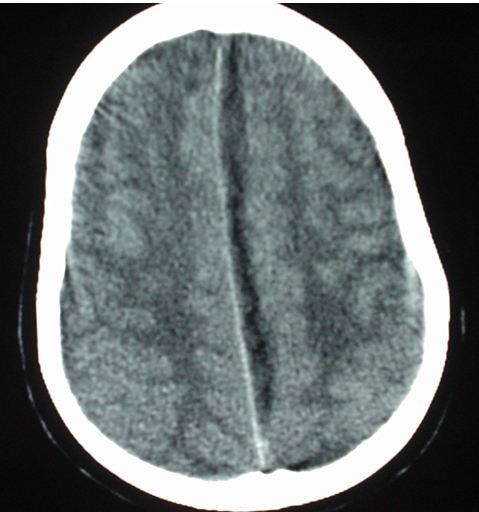Headache and a Weak Leg in an 11-year-old Boy
Cold symptoms that persisted for several weeks became ominous signs when the headache worsened and walking became difficult.
Figure 1.

An 11-year-old boy is sent to the emergency department (ED) by his pediatrician based on the clinician’s suspicion of meningitis. The child has had nasal congestion, slight cough, headache, and fever on and off for about two to three weeks. His mom thought it was just a regular cold so gave it a few weeks to clear up but three days ago she finally decided it had been going on too long and took him to his doctor. He was diagnosed with the flu and the mother was reassured that, antibiotics were not required and that he should improve over the next few days. Since then, however, the boy’s headache worsened, the fever reached 102°F, and the child has developed weakness in his right leg with some trouble walking. They phoned the pediatrician who now directed them to the local emergency department to be evaluated for meningitis.
On physical examination the child’s vital signs are normal except for a temperature of 100.6°F. Eyes are clear without photophobia, but there is purulent nasal discharge on the left side. The neck is without mass but there is mild meningismus. Examinations of the heart, lungs, and abdomen are unremarkable. Skin is clear without rash. Neurologic exam shows notable right leg weakness with 15 beats of clonus and a positive Babinski sign on the right leg only. Examinations of the left leg and both arms are normal.
Results of a chest x-ray are normal as are those of a screening complete blood count and a metabolic panel. A CT scan of the head is performed and one cut is shown in Figure 1(please click on image to enlarge).
The radiologist is uncertain of the significance of the midline left parafalcine fluid collection, but says since there is no mass effect, you may proceed with a spinal tap.
What is the differential diagnosis? What is your diagnosis?
What is the best course of action?
Please leave your thoughts below; for answer and discussion, please click here.
Diagnosis: Subdural Empyema
Don’t do the LP! This is a subdural empyema which is a particularly bad type of brain abscess.
Discussion
A subdural empyema is a brain abscess in the subdural space. Like a subdural hematoma its appearance on head CT tends to be crescent shaped when on the periphery with ability to cross suture lines, however the density is similar to water and it therefor appears dark. When the location is along the midline falx the appearance is similar to the CT in this case. Subdural empyemas are less common than intraparenchymal or epidural brain abscesses but they have a tendency to progress rapidly and thus require urgent surgical drainage in most cases. See Figure2, below, showing multiple intraparenchymal brain abscesses with surrounding edema for comparison.
[[{"type":"media","view_mode":"media_crop","fid":"41158","attributes":{"alt":"","class":"media-image media-image-right","id":"media_crop_2763879395458","media_crop_h":"0","media_crop_image_style":"-1","media_crop_instance":"4302","media_crop_rotate":"0","media_crop_scale_h":"0","media_crop_scale_w":"0","media_crop_w":"0","media_crop_x":"0","media_crop_y":"0","style":"height: 272px; width: 265px; float: right;","title":"Figure 2. ","typeof":"foaf:Image"}}]]
The rest of this discussion will cover brain abscesses in general rather than just subdural empyemas.
Brain abscess typically present with a combination of symptoms. As noted in the Table below, the most common symptom is headache, occurring in about 70% of cases, followed by altered mental status, fever, and focal neurologic symptoms. In this case, the right leg weakness corresponded to the homunculus for motor function. Many symptoms of brain abscesses mimic those of meningitis. Clues to the presence of brain abscess as opposed to meningitis include focal neurologic findings as well as a more subacute time course with progression over weeks rather than just days. Neck stiffness and photophobia are uncommon in brain abscess as well. Risk factors for brain abscesses are listed in the Table.
Testing for brain abscess focuses on head CT because blood work is rarely helpful and LP is contraindicated. Indications for head CT prior to LP when there is suspicion for meningitis typically include age >60 years, immune suppression, history of brain disease, seizure, confusion, recent sinusitis or otitis media, focal neurologic findings, or papilledema. Symptoms for more than a week prior to presentation should also be considered as this makes a brain abscess relatively more likely and meningitis relatively less likely. Imaging that reveals a brain abscess may also reveal a nearby cause such as sinusitis, otitis media, mastoiditis, or other causes.
Treatment for brain abscesses involves IV antibiotics for 6 weeks with or without surgical drainage or imaging-guided aspiration, depending on size and location. Surgical drainage may also be required for any contributing nearby focal infections. Antibiotics will need to cover staph, strep, and anaerobes. See Table for one common antibiotic regimen. Seizure prophylaxis may also be prudent.
Table.
Round shape, often need surgery, but if small ABX alone may work (see Figure 2)
Subdural Empyema: Crescent shape, rapid progress so needs urgent drainage, 12% die
Epidural Abscess: Lens shape, bound by dura so usually progresses slowly
" target="_blank">
Click image for details.
